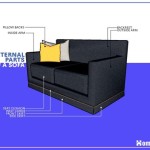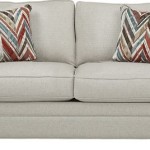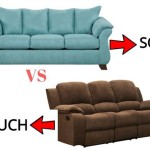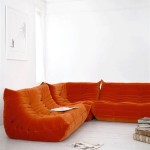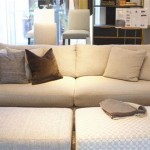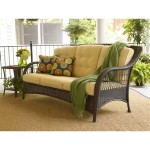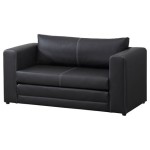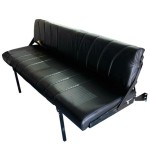Exploring Sofa Beds Without Backs: Functionality and Design
Sofa beds, also commonly known as convertible sofas, have long been recognized as a practical solution for maximizing space and providing versatile seating and sleeping arrangements. Among the diverse range of sofa bed designs, the "sofa bed no back" model presents a unique approach to adaptability, offering a minimalist aesthetic and functional benefits that cater to specific needs and preferences. This article delves into the characteristics, advantages, considerations, and applications of sofa beds without backs, providing a comprehensive understanding of this particular furniture type.
The defining feature of a sofa bed without a back is its absence of a dedicated backrest in its sofa configuration. Instead, it typically relies on cushions or the wall for back support. This design choice significantly impacts its appearance, footprint, and functionality. It’s important to differentiate this style from futons, which often have a folding mechanism to create a flat sleeping surface. Sofa beds without backs generally have a pull-out or fold-out mattress hidden within the sofa frame.
Key Features and Design Variations
The construction of a sofa bed lacking a back is usually straightforward. The frame, often made of wood or metal, houses the mattress and the mechanism for converting it into a bed. The seating area, which forms the surface of the sofa, can be upholstered in a variety of materials, including fabric, leather, or synthetic alternatives. The absence of a traditional backrest necessitates careful consideration of cushion placement and support systems to ensure comfortable seating.
Design variations in this category are numerous. Some models feature integrated side tables or armrests for added functionality. Others prioritize a low-profile design, blending seamlessly into minimalist interiors. The size of the mattress also varies, ranging from twin to queen size, accommodating different sleeping needs. The pull-out mechanism itself can present different configurations, such as a simple pull-out frame, a fold-out design, or a more sophisticated mechanism with hidden legs that automatically deploy.
Upholstery options are equally diverse. Durable fabrics like microfiber and canvas are popular choices for their resistance to wear and tear. Leather and faux leather offer a more luxurious aesthetic and are easier to clean. The choice of upholstery significantly affects the overall look and feel of the sofa bed, influencing its integration into the existing decor.
Beyond the core design elements, manufacturers often incorporate additional features such as storage compartments beneath the seating area. This storage space can be invaluable for storing bedding, pillows, or other items, further enhancing the functionality of the sofa bed.
Advantages of a Backless Sofa Bed
The absence of a backrest in a sofa bed offers several distinct advantages, making it a suitable choice for particular spatial configurations and design preferences. These include enhanced space utilization, adaptability, and aesthetic versatility.
Space Optimization: One of the primary benefits is its space-saving potential. Without a cumbersome backrest, the sofa bed occupies less depth, making it ideal for small apartments, studio spaces, or multi-purpose rooms where minimizing the footprint of furniture is crucial. The minimalist design contributes to an open and airy feel, visually expanding the space.
Adaptability and Placement Flexibility: The absence of a backrest allows for greater freedom in positioning the sofa bed within a room. It can be placed against a wall, used as a room divider, or positioned in the center of a space without obstructing views. This versatility is particularly useful in open-concept living areas where furniture arrangements need to be fluid and adaptable.
Aesthetic Versatility: The streamlined design of a sofa bed without a back lends itself well to various interior design styles. Its minimalist form can complement modern and contemporary aesthetics, while the upholstery and cushion choices can be tailored to match a wide range of color palettes and textures. The lack of a backrest allows the surrounding decor to take center stage, creating a cohesive and visually appealing environment.
Cost-Effectiveness: In some cases, sofa beds without backs may be more affordable compared to traditional sofa beds with full backrests. This is due to the simpler construction and reduced material requirements. This can make it an attractive option for budget-conscious consumers seeking a functional and space-saving seating and sleeping solution.
Considerations and Potential Drawbacks
While sofa beds without backs offer numerous advantages, it's essential to consider their potential drawbacks and limitations. These include comfort considerations, the need for external back support, and potential aesthetic challenges.
Comfort and Support: The absence of a dedicated backrest can impact seating comfort. Users may need to rely on cushions or pillows for back support, which can be less ergonomic than a traditional sofa back. The quality and placement of these cushions are crucial for ensuring a comfortable and supportive seating experience. Careful selection of cushions with adequate firmness and lumbar support is essential.
Reliance on External Support: As previously mentioned, the sofa bed requires external back support, either from cushions or a wall. This can limit its placement options in some situations. If the sofa bed is positioned in the center of a room, it may not provide adequate back support unless additional support structures are incorporated into the design.
Aesthetic Limitations: While the minimalist design can be advantageous, it may not appeal to all aesthetic preferences. Some individuals may prefer the traditional look and feel of a sofa with a defined backrest. The lack of a backrest can also create a less formal or inviting appearance, depending on the overall design of the room.
Mattress Quality: As with all sofa beds, the quality of the mattress is a crucial factor in determining sleeping comfort. It’s important to research the type of mattress used in the sofa bed, its thickness, and its support system. Some sofa beds may utilize thin or less supportive mattresses, which can result in an uncomfortable sleeping experience. Consider upgrading the mattress if necessary.
Durability of Mechanism: The pull-out or fold-out mechanism is a critical component of the sofa bed. It should be robust and durable to withstand repeated use. A poorly constructed mechanism can be prone to failure, reducing the lifespan of the sofa bed. Before purchasing, carefully inspect the mechanism and read reviews from other users to assess its reliability.
Cleaning Considerations: The upholstery material should be easy to clean and maintain. Light-colored fabrics can be susceptible to staining, while darker colors may show wear and tear more readily. Consider the potential for spills and stains when choosing an upholstery material. Regularly cleaning the sofa bed can help to extend its lifespan and maintain its appearance.
Weight Capacity: Before purchasing, check the weight capacity of the sofa bed to ensure that it can safely accommodate the intended users. Overloading the sofa bed can damage the frame and mechanism, reducing its lifespan and potentially causing injury.
Assembly Requirements: Some sofa beds may require assembly upon delivery. It’s important to review the assembly instructions and ensure that all necessary tools and hardware are included. If you are not comfortable assembling the sofa bed yourself, consider hiring a professional to do so.
Warranty and Return Policy: Before making a purchase, carefully review the warranty and return policy offered by the manufacturer or retailer. A comprehensive warranty can protect you against defects in materials and workmanship. A flexible return policy allows you to return the sofa bed if you are not satisfied with its quality or performance.
By carefully considering these potential drawbacks, consumers can make informed decisions about whether a sofa bed without a back is the right choice for their needs and preferences.
Applications and Ideal Scenarios
Sofa beds without backs are particularly well-suited for specific applications and scenarios. Their space-saving design and adaptability make them ideal for smaller living spaces, guest rooms, and multi-functional areas.
Small Apartments and Studio Spaces: In compact living environments, maximizing space is paramount. The reduced footprint of a sofa bed without a back makes it an excellent choice for small apartments and studio spaces where every square foot counts. It provides comfortable seating during the day and a convenient sleeping solution for overnight guests without sacrificing valuable floor space.
Guest Rooms: A guest room often serves multiple purposes, functioning as an office, hobby room, or storage space when not in use by guests. A sofa bed without a back can be a versatile addition to a guest room, providing comfortable seating and a convenient sleeping option without dominating the space. Its minimalist design allows it to blend seamlessly into the room's existing decor.
Home Offices: Many individuals now work from home, requiring a dedicated office space. A sofa bed without a back can be a valuable addition to a home office, providing a comfortable spot to relax during breaks or a convenient sleeping option for overnight guests. Its adaptable design allows it to be easily converted from a seating area to a sleeping space as needed.
Multi-Purpose Rooms: In homes with limited space, rooms often serve multiple functions. A sofa bed without a back is ideal for multi-purpose rooms, such as living rooms that double as guest rooms or playrooms that double as sleeping areas. Its space-saving design and adaptability make it a practical and versatile furniture choice.
Minimalist Interiors: The clean lines and understated design of a sofa bed without a back complement minimalist interior design styles. It integrates seamlessly into minimalist spaces, enhancing the overall aesthetic without creating clutter.
Ultimately, the decision of whether or not to purchase a sofa bed without a back depends on individual needs, preferences, and the specific characteristics of the living space. By carefully evaluating the advantages and disadvantages, consumers can determine if this unique furniture piece is the right fit for their lifestyle.

Merga Detach Sofa Bed Full Size Luanda Sand By Innovation In 2024

First Class Cabin Futon Couch Bed With Convertible Back And Orange Polyester Newit

Neo Armless Single Sofa Bed In Fabric

Splitback Sofa Bed With Arms

Desket Siesta Sofa Cum Bed Direct From Factory Customizable Furniture Bangalore

Mopio Aaron Futon Twin Size Convertible Sofa Sleeper With Arms Split Back Design 77 5 Dark Gray Fabric Com

Greeley Foldable Split Back Sofa Bed Grey Fully Furnished

Lacoo Modern Linen Fabric Futon Sofa Bed Split Back With Pillows 76 Brown Com

Homcom Convertible Sofa Futon Velvet Touch Tufted Couch Bed Split Back Grey Diy At B Q

Choosing Your Sofa Bed Mattress Celebrating British Design Culture

